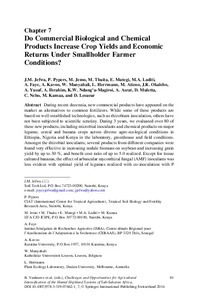| dc.contributor.author | Jefwa, J.M. |
| dc.contributor.author | Pypers, Pieter |
| dc.contributor.author | Jemo, M. |
| dc.contributor.author | Thuita, M. |
| dc.contributor.author | Mutegi, E. |
| dc.contributor.author | Laditi, M.A. |
| dc.contributor.author | Faye, A. |
| dc.contributor.author | Kavoo, A. |
| dc.contributor.author | Munyahali, W. |
| dc.contributor.author | Herselman, L. |
| dc.contributor.author | Atieno, M. |
| dc.contributor.author | Okalebo, J.R. |
| dc.contributor.author | Yusuf, A. |
| dc.contributor.author | Ibrahim, A. |
| dc.contributor.author | Ndung’u-Magiroi, K.W. |
| dc.contributor.author | Asrat, A. |
| dc.contributor.author | Muletta, D. |
| dc.contributor.author | Ncho, C. |
| dc.contributor.author | Kamaa, M. |
| dc.contributor.author | Lesueur, Didier |
| dc.date.accessioned | 2019-12-04T11:10:22Z |
| dc.date.available | 2019-12-04T11:10:22Z |
| dc.date.issued | 2014 |
| dc.identifier.citation | Jefwa, J.M., Pypers, P., Jemo, M., Thuita, M., Mutegi, E., Laditi, M.A., ... & Lesueur, D. (2014). Do commercial biological and chemical products increase crop yields and economic returns under smallholder farmer conditions? In B. Vanlauwe, P. van Asten and G. Blomme, Challenges and opportunities for agricultural intensification of the humid highland systems of sub-Saharan Africa (p. 81-96). Switzerland: Springer International Publishing. |
| dc.identifier.isbn | 978-3-319-07662-1 |
| dc.identifier.uri | https://hdl.handle.net/20.500.12478/2112 |
| dc.description.abstract | During recent decennia, new commercial products have appeared on the market as alternatives to common fertilizers. While some of these products are
based on well-established technologies, such as rhizobium inoculation, others have not been subjected to scientific scrutiny. During 3 years, we evaluated over 80 of these new products, including microbial inoculants and chemical products on major legume, cereal and banana crops across diverse agro-ecological conditions in Ethiopia, Nigeria and Kenya in the laboratory, greenhouse and field conditions. Amongst the rhizobial inoculants, several products from different companies were found very effective in increasing nodule biomass on soybean and increasing grain yield by up to 30 %, and benefit-cost ratio of up to 5.0 realized. Except for tissue cultured bananas, the effect of arbuscular mycorrhizal fungal (AMF) inoculants was less evident with optimal yield of legumes realized with co-inoculation with P solubilizing bacteria and when supplemented with inorganic fertilizer such as DAP. Other products containing Trichoderma or Bacillus spp. improved growth under field conditions, soil-dependent growth improvements of over 40% in tissue culture bananas. The potential of products to reduce soil pathogenic rhizosphere organisms, particularly Fusarium, was also observed. Chemical products evaluated, special attention was given to alternative P fertilizers such as leaf sprays, seed coatings and conditioners with humic acids. The effect on cereals depended on the crop, the soil and accompanying agronomic measures. Benefit-cost ratios were favorable for seed P coating Teprosyn, because this is a fairly inexpensive treatment (US $ 3 ha 1). Results demonstrate economic returns of US$ 4 for every dollar invested for soybean production and US $ 4.6 for every dollar invested in maize production. The Net benefit of US $ of 5,265 for Rhizatech matches benefits of US $ 5,115 derived from Conventional practice with half investment of US $ 62 compared to US $ 135. The potential for biological and chemical commercial products is evident and the need for continued evaluation. Smallholders may benefit from good quality
products that are correctly applied to the appropriate crop under appropriate soil and crop management. |
| dc.description.sponsorship | Bill & Melinda Gates Foundation |
| dc.format.extent | 81-96 |
| dc.language.iso | en |
| dc.publisher | Springer |
| dc.subject | Agricultural Inputs |
| dc.subject | Commercial Farming |
| dc.subject | Soil Management |
| dc.title | Do commercial biological and chemical products increase crop yields and economic returns under smallholder farmer conditions? |
| dc.type | Book Chapter |
| dc.description.version | Peer Review |
| cg.contributor.crp | Roots, Tubers and Bananas |
| cg.contributor.affiliation | Soil Tech Limited Nairobi |
| cg.contributor.affiliation | International Center for Tropical Agriculture |
| cg.contributor.affiliation | International Institute of Tropical Agriculture |
| cg.contributor.affiliation | Institut Sénégalais de Recherches Agricoles |
| cg.contributor.affiliation | Karatina University |
| cg.contributor.affiliation | Katholieke Universiteit Leuven |
| cg.contributor.affiliation | Deakin University |
| cg.coverage.region | Africa |
| cg.coverage.region | West Africa |
| cg.coverage.region | East Africa |
| cg.coverage.country | Ethiopia |
| cg.coverage.country | Nigeria |
| cg.coverage.country | Kenya |
| cg.authorship.types | CGIAR and developing country institute |
| cg.iitasubject | Soil Fertility |
| cg.howpublished | Formally Published |
| cg.accessibilitystatus | Limited Access |
| local.dspaceid | 90641 |
| cg.identifier.doi | http://dx.doi.org/10.1007/978-3-319-07662-1_7 |

